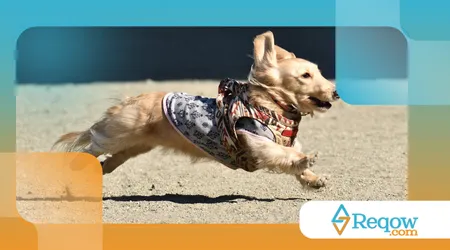How to avoid injuries in dogs that run a lot

It is crucial to learn how to prevent injuries in dogs that run a lot, ensuring that their passion for speed does not become a source of pain.
Advertisements
Dog sports, or simply the euphoria of daily running, require extra attention from owners.
Why Does Speed Increase the Risk of Injury?
The high energy and propensity for intense running, characteristic of many breeds, require conscious management.
Therefore, speed exposes the dog's body to repetitive impacts and sudden movements that can overload joints, muscles and ligaments.
Ignoring this reality is a common but potentially serious mistake.
Advertisements
Canine enthusiasm often masks fatigue or mild pain, making early detection of problems a challenge.
How can we enable them to enjoy running without compromising their longevity and well-being?
How Can Proper Physical Preparation Help Prevent Injuries in Dogs That Run A Lot?
Prevention begins long before the collar is put on.
A well-structured fitness program is the backbone of a healthy running dog. This includes a warm-up and cool-down.
A dog is no different from a human athlete. Cold muscles are more susceptible to strains and tears. Gentle but active stretching before running is vital.
Therefore, cooling down allows your heart rate and breathing to gradually return to normal, helping to remove metabolic waste.
This prevents post-exercise muscle soreness.
Read more: Tips to help your dog recover from surgery
A common mistake is to take the dog from complete rest to a high-intensity run.
Gradual progression of exercise load is essential to strengthen musculoskeletal structures.
What Training Strategies Reduce Impact in Running Dogs?
Diversity of surfaces and variation in the type of exercise are smart training strategies.
Always running on asphalt, for example, significantly increases joint stress.
Therefore, alternating between grass, dirt, and sand (in moderation) distributes the impact more evenly. Think of it as a natural shock absorber.
Including strength and proprioception training strengthens stabilizing muscles. This improves balance and coordination, which are essential for prevent injuries in dogs that run a lot.
Look how interesting: Essential dog care during heat waves
Exercises such as passing over low obstacles or walking on uneven terrain (in a controlled manner) optimize the animal's body awareness.
So, think of it as "cone training": guiding your dog in a zigzag pattern between cones. This improves agility and the ability to decelerate in a controlled manner.
On the other hand, imagine the cavaletti, small floor bars that the dog needs to lift its paws to pass. This strengthens the core and the muscles of the limbs.

Why Are Nutrition and Body Weight Key Elements in Prevention?
A running dog's diet should be formulated to support high energy expenditure and tissue regeneration. Specific supplements may be beneficial.
++ How to transition from puppy to adult food
In other words, being overweight is a substantial risk factor for injuries. Every extra pound puts strain on already vulnerable joints, especially hips and elbows.
Keep a score Maintaining ideal body condition is as important as the training itself. An animal's physical shape is a direct reflection of its overall health.
| Injury Risk Indicator | Impact on the Running Dog |
| Overweight | Increased pressure on joints (knee and hip) |
| Inadequate Diet | It hinders muscle recovery and bone health |
| Lack of Heating | Increased risk of muscle strains and sprains |
| Overtraining | Fatigue, stress bone and repetitive use injuries |
According to data from American Veterinary Medical Association (AVMA), obesity increases a dog's likelihood of developing joint problems by up to 3.5 times.
This is a statistic that should make us reflect.
When does active rest become essential to prevent injuries in dogs that run a lot?
Rest is, ironically, a fundamental part of training. The body needs time to heal and strengthen after the stress of exercise.
Therefore, periods of active rest, such as slow walks or gentle swimming, allow recovery without total inactivity. This keeps circulation active.
Careful observation by the owner is essential. Subtle signs of lameness, reluctance to run, or changes in behavior indicate the need for a break.
It is vital to respect the recovery cycle to prevent injuries in dogs that run a lot and ensure a long and enjoyable sporting career.
What to Do to Monitor Your Dog's Joint Health?
Regular veterinary checkups, including orthopedic evaluations, are essential. Early detection of abnormalities makes all the difference in prognosis.
A veterinarian may suggest imaging tests and chondroprotective supplements (to protect cartilage) tailored to your friend's individual needs.
Just as a race car needs constant maintenance to avoid breaking down on the track, your dog needs proactive veterinary care.
Similarly, canine massage and physiotherapy are valuable tools. They help identify tension points and promote muscle relaxation.
Remember: neglecting body maintenance is like expecting a rubber band stretched to its maximum length to not break. It's just a matter of time.

What Signs Indicate That I Should See a Veterinarian Immediately?
Sharp pain, sudden swelling of a joint, inability to put weight on a paw, or a drastic change in gait are red flags.
Any sign that prevents you from running with the same joy and ease should be investigated. Don't wait for it to "get better on its own."
Prevention is always the best way to prevent injuries in dogs that run a lot and sustain quality of life.
Are you doing everything you can to ensure your athlete's safety?
The responsibility of an active dog owner is to ensure that running is a safe and enjoyable experience. Investing in prevention is key.
This way, you help prevent injuries in dogs that run a lot, keeping your partner healthy.
And what's more, it's crucial to prevent injuries in dogs that run a lot quality management. Prioritize health for prevent injuries in dogs that run a lot.
The Prevention Race
Being the guardian of a dog that loves to run is an immense joy. However, it's a role that requires dedication and knowledge. prevent injuries in dogs that run a lot.
Prevention, which includes conditioning, nutrition and monitoring, is our greatest ally.
By taking a proactive approach, we ensure that our four-legged friend's passion for speed is celebrated safely and healthily for many years to come.
It is the commitment to well-being that defines excellence in tutoring.
The key is to maintain a balance between exercise and rest, valuing joint health to prevent injuries in dogs that run a lot.
Frequently Asked Questions
What is the ideal age to start high-intensity training?
Generally, high-impact activity should be avoided until bone growth is complete, which occurs around 12 to 18 months, depending on the breed.
Consult a veterinarian to assess individual bone development.
What are chondroprotectors and are they really necessary?
Chondroprotectors are supplements that help protect and regenerate joint cartilage.
They can be very beneficial, especially for dogs with high joint wear, but the recommendation must be made by a veterinarian.
Is swimming a good exercise for running dogs?
Yes, swimming is excellent. It's a low-impact exercise that strengthens muscles without putting strain on joints, making it ideal for recovery or cross-conditioning.
